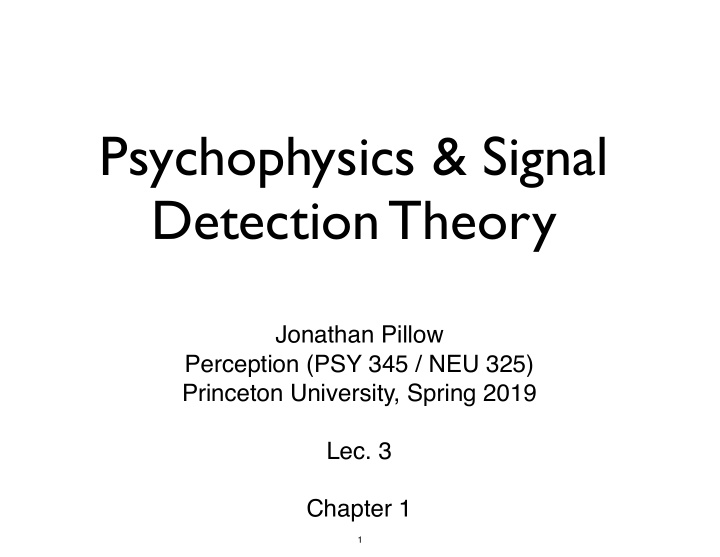



Psychophysics & Signal Detection Theory Jonathan Pillow Perception (PSY 345 / NEU 325) Princeton University, Spring 2019 Lec. 3 Chapter 1 1
Outline for today: • Stephen’s power law • psychophysics • Signal Detection Theory 2
Stevens’ Power Law 3
Stevens’ Power Law • subjective • based on rating data • no “right” answer: just a mapping between one unknown scale (‘pain’) and another unknown scale (‘numbers’) (my rating: “meh”) 4
Test yourself: at which intensity are changes most detectable? A B C 5
For this stimulus/sensation relationship, which stimulus changes are most detectable? A B C 6
How to measure perception? 7
müller-ly er illusion 8
“percept” “percept” is internal müller-lyer illusion 9
Psychophysics • detection (yes/no) • discrimination (e.g., bigger than) • estimation (report the stimulus exactly) All provide indirect measure of internal mental state! 10
11
Detection perfect threshold 12
Detection perfect threshold noise 13
psychometric function • relates physical quantity to the probability of detecting it 14
Signal detection theory : A psychophysical theory that quantifies the response of an observer to the presentation of a signal in the presence of noise ( On board ) 15
Detecting a stimulus using the signal detection theory (SDT) 16
Detecting a stimulus using the signal detection theory (SDT) 17
Sensitivity to a stimulus: The separation between the distributions of response to noise alone and to signal plus noise 18
For a fixed d ʹ , shifting the response criterion 19
Signal detection theory � Hit : Stimulus is presented and observer responds “Yes” � Miss : Stimulus is presented and observer responds “No” � False alarm : Stimulus is not presented and observer responds “Yes” � Correct rejection : Stimulus is not presented and observer responds “No” 20
Signal Detection Theory Terms to know: “noise” distribution : values arising when stimulus not present “signal” distribution : values arising when signal + noise present Type I error : rate of “false alarms”, or false positives Type II error : rate of “misses”, or false negatives psychometric function : describes probability of saying “I heard it” as function of stimulus intensity 21
Chapter 1 Summary • Weber-Fechner law • Stevens’ power law • psychophysics • psychometric function • signal detection theory: threshold, criterion, Hit/ Miss, FA/CR, d’ (i.e., “d-prime”) • spikes, synapses, neurotransmitter 22
You can safely ignore (for now) • method of constant stimuli / method of adjustment • ROC curves • Fourier analysis (though we will come back to it!) • Cranial nerves (Fig 1.20) • brain anatomy (Fig 1.21, but we will come back as needed) 23
Next: Read Chapter 2 24
Recommend
More recommend